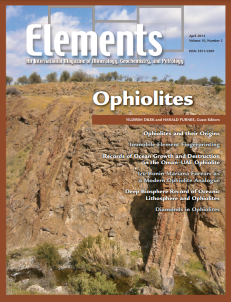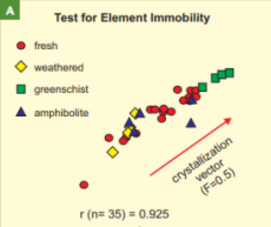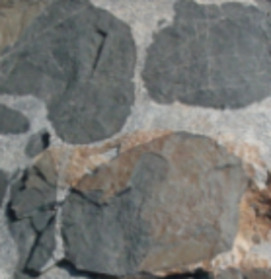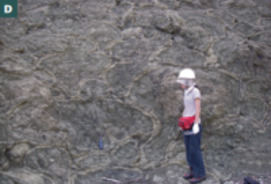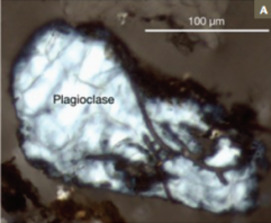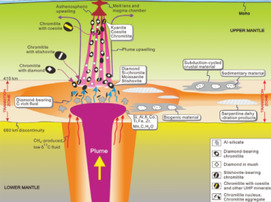
Ophiolites
Yildirim Dilek and Harald Furnes – Guest Editors
Table of Contents
This thematic issue will cover some of the most exciting advances in ophiolite science. Focus is directed toward ophiolite classification during the formation and destruction of ocean basins; the mineralogy, petrology, and isotope geochemistry of ophiolites; and the trace element behavior of crustal and upper-mantle units in ophiolites. The issue will cover the history of origin, the geochemical and petrological develop- ment, and the fi nal emplacement of one of the largest and most studied ophiolites, the classical Semail ophiolite in Oman. Further, for a better understanding of ophiolites in relation to subduction processes, one of the papers deals with the lithological and geochemical development of the Izu-Bonin-Mariana forearc crust as a modern analogue. Finally, the issue will present some of the new and exciting aspects of microbial interaction with the volcanic component of oceanic crust, as observed in ophiolites as old as the young Earth.
- Ophiolites and Their Origins
- Immobile Element Fingerprinting of Ophiolites
- Records of Ocean Growth and Destruction in the Oman–UAE Ophiolite
- Izu-Bonin-Mariana Forearc Crust as a Modern Ophiolite Analogue
- Deep Biosphere Record of In Situ Oceanic Lithosphere and Ophiolites
- Diamonds in Ophiolites
AHF Analysentechnik
Australian Scientific Instruments (ASI)
Bruker Nano
Cambridge University Press
Cameca
Elementa
FEI
Excalibur Mineral Corporation
Geochemist’s Workbench
Horiba
JEOL
Rigaku
Savillex
Tescan Orsay Holding
Zeiss
Thermo
v10n3 KAOLIN: FROM ANCIENT PROCELAINS TO NANOCOMPOSITES
Guest Editors: Paul A. Schroeder (University of Georgia) and David L. Bish (Indiana University)
Although bearing the simple name “kaolin,” this natural material has a variety of geologic origins and many industrial applications significant to society. Known as china clay, kaolin has a long history dating back to Kauling, China, and its fi rst exploitation in the field of ceramics. Kaolin is one of nature’s most abundant nanomaterials. Its fi ne, clay- sized particles, unique shapes, and layered structures make it central to Earth’s near-surface critical zone. Concerns for energy efficiency and environmental awareness in the industry have led to advances in mining and reclamation practices. The crystallographic and elemental varieties of kaolin require them to be carefully characterized as they lend themselves for use in plastics, papers, pigments, and ceramics. Kaolin minerals are being probed with computational chemistry and new spectroscopic tools to expand their applications and to understand their significance in biology. We are now exploring how kaolin can be nanocomposited to create materials with novel properties.
- Kaolin: From Ancient Porcelains to Nanocomposites By Paul A. Schroeder and Gary Erickson (Macalester College)
- Kaolin-Group Minerals: From Hydrogen-Bonded Layers to Environmental Recorders By Etienne Balan (IRD and UPMC, Paris), Georges Calas (UPMC, Paris), and David L. Bish (Indiana University)
- Mining and Processing Kaolin By Jessica Elzea Kogel (IMERYS)
- Interactions of Kaolin Minerals in the Environment By Randall T. Cygan (Sandia National Laboratories) and Kazue Tazaki (Kanazawa University)
- From Platy Kaolinite to Nanorolls By Christian Detellier (University of Ottawa) and Robert A. Schoonheydt (KU Leuven)
- Kaolins and Health: From First Grade to First Aid By Lynda B. Williams (Arizona State University) and Stephen Hillier (The James Hutton Institute, Aberdeen)
- Asteroids: Linking Meteorites and Planets (February 2014)
- Ophiolites (April 2014)
- Kaolin (June 2014)
- Unconventional Hydrocarbons (August 2014)
- Cosmogenic Nuclides (October 2014)
- Graphitic Carbon (December 2014)
Download 2015 Thematic Preview


